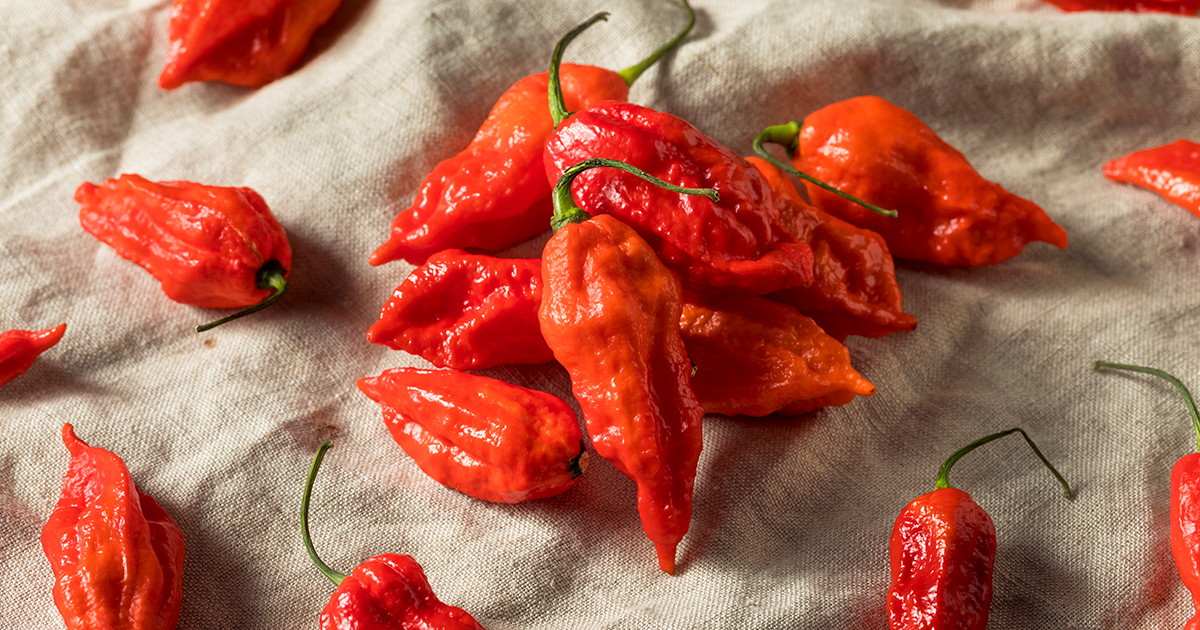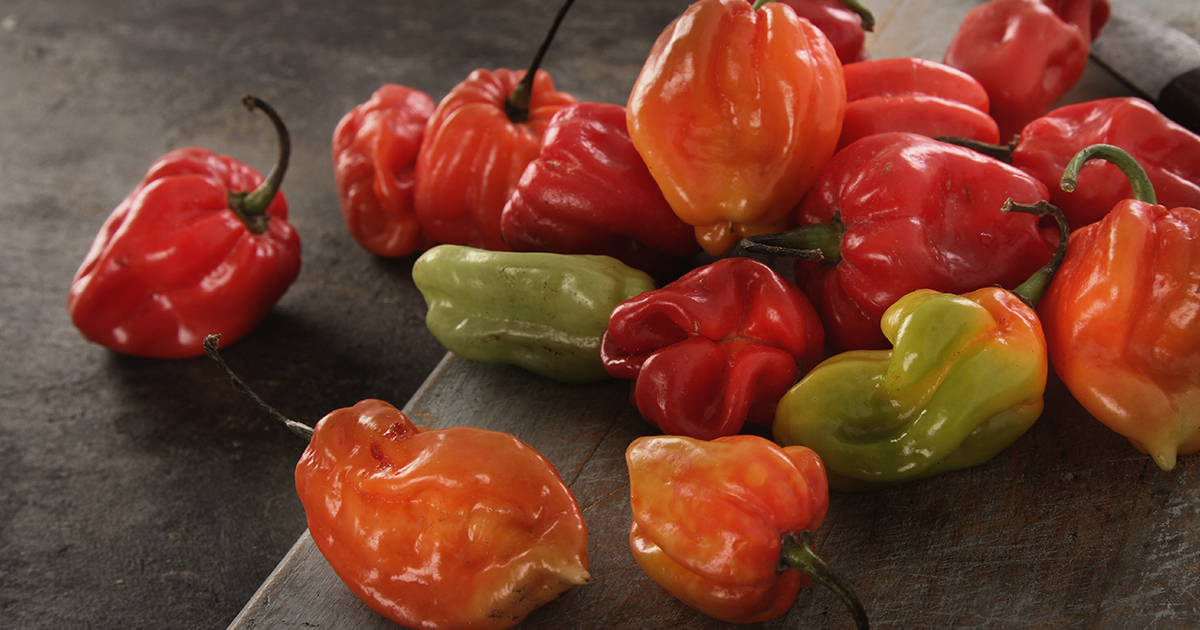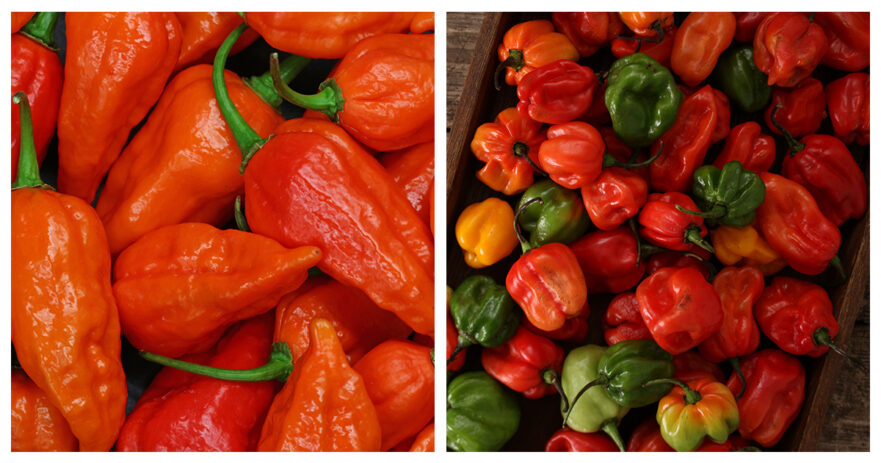If you’re a big fan of fiery cuisine, then you’re certainly aware of the fact that different peppers will provide a specific taste and level of spiciness to your food. When it comes to enjoying the hottest peppers in the world, the ghost pepper and Scotch bonnet are undoubtedly two of the most sought-after…but what makes them different from one another? Let’s delve into the characteristics of these two spicy peppers and find out which one is the right fit for your recipe.
| Ghost pepper | Scotch bonnet | |
| SHU | 855,000 - 1,041,427 | 100,000 - 350,000 |
| Median SHU | 948,214 | 225,000 |
| Flavor | Fruity and slightly sweet, with a very intense heat | Sweet, fruity, tropical, citrusy |
| Species | Hybrid of Capsicum chinense x Capsicum frutescens | Capsicum chinense |
| Origin | Northern India | South America |
| Uses | Hot sauces, salsas, curries, pickling, etc. | Sauces, dry rubs, marinades, salsas, soups, curries |
Table of contents
What is the Ghost Pepper?

The Ghost pepper, also called the bhut jolokia, is a pepper that’s been grown in Northeast India for centuries. It was awarded the title of the Guinness World Record for the world’s hottest chili pepper back in 2007, and its heat level is measured at slightly over 1,000,000 Scoville heat units (SHU). Ghost peppers have a great flavor profile, with a distantly fruity and sweet aftertaste that makes them a great addition to any number of meals.
Ghost peppers also have a unique appearance, with a reddish-orange color and bumpy texture. They‘re much hotter than many other popular chili peppers like jalapeño and habanero. Ghost peppers can be dried and ground into a powder too, which is a common and delicious ingredient in various spice blends and hot sauces.
The rise in popularity of ghost peppers has been driven in large part by people‘s growing interest in spicy and exotic cuisine, as well as the rise of the hot sauce industry. As more people seek out new and exciting flavors, ghost peppers have become a sought-after ingredient for home cooks and professional chefs alike.
Despite their popularity, it’s important to handle ghost peppers with extreme care still. The capsaicin in these peppers can cause serious irritation to the skin and eyes, so it’s recommended that you wear gloves when handling them and don’t touch your face. Also, be mindful of just how much ghost pepper you’re adding to your dishes, as even a tiny amount can make them incredibly spicy.
What is a Scotch Bonnet?

The Scotch bonnet is a type of chili pepper that‘s a staple across Caribbean cuisine. With a heat level of 100,000 to 350,000 SHU, it’s less hot than the ghost pepper, but it still packs a solid punch. Scotch bonnet peppers have a bright orangey-red color and a unique shape among peppers, resembling a cute little Scottish tam o’ shanter hat.
Scotch bonnet peppers have a fruity, tropical flavor that pairs excellently with jerk seasoning and other traditional Caribbean spices. They‘re used all the time in hot sauces, marinades, and curries and can be used fresh or dried. For items like Jamaican jerk chicken and Trinidadian pepper sauce, Scotch bonnets are usually one of the main ingredients.
Scotch bonnet peppers also go by a variety of names around the world, such as Bahama Mama, Martinique pepper, or Bonney pepper. This pepper is grown in across Jamaica, Haiti, and the Dominican Republic, along with a few other places. It‘s also a popular ingredient in many cuisines, including West African and Maldivian, that aren’t in the Caribbean!
One especially unique thing about Scotch bonnets is that they‘re often used not just for how they taste but also for how they look. In Jamaica, Scotch bonnet peppers are sometimes used as a garnish for different dishes, adding both visual appeal and an extra kick of spice.
What are the Similarities Between Ghost Peppers and Scotch Bonnets?
Despite being from different regions and having distinctive flavor profiles, ghost peppers and Scotch bonnets do share some similarities in terms of their heat level and versatility in the kitchen.
Firstly, both Ghost peppers and Scotch bonnets are chili peppers that are well-known for their high heat levels. The Ghost pepper once held the Guinness World Record for the world’s hottest chili pepper, while the Scotch bonnet holds a solid spot among the hottest peppers in the world. Both peppers are extremely hot and should be used sparingly in dishes, and those who can‘t handle spicy foods are definitely advised to avoid them.
Secondly, both ghost peppers and Scotch bonnets are super popular ingredients in sauces and seasoning blends. They‘re commonly used in Indian and Caribbean cuisines, respectively, and add depth and complexity to the various dishes. The fruity and sweet notes of the ghost pepper and the tropical flavors of the Scotch bonnet make them each great additions to yummy things like hot sauces, marinades, and rubs.
Also, both ghost peppers and Scotch bonnets can be dried out and ground into powder, which can be used as a spice in all sorts of dishes! These ground peppers are commonly found in spice blends and can be used to add heat to any recipe you choose. They can also easily be used as a substitute for one another in recipes, although you may get some differing heat levels.
Despite how hot they each are, both ghost peppers and Scotch bonnets are incredibly versatile ingredients that can be used in a range of dishes. They can add a kick to traditional items but can also be used in more unconventional ways, such as a seasoning for roasted vegetables.
What are the Differences Between Ghost Peppers and Scotch Bonnets?
While both ghost peppers and Scotch bonnets are extremely hot chili peppers, there are some definite differences in their flavor, appearance, and uses when it comes to cooking.
In terms of appearance, ghost peppers are bumpy and reddish-orange, while Scotch bonnet peppers are usually smoother and have a distinctive tam o’ shanter shape.
Both peppers are indeed very hot, but the ghost pepper is definitely hotter, with a Scoville rating of over 1,000,000 SHU compared to the Scotch bonnet’s 100,000 to 350,000 SHU.
When it comes to cooking, both of these peppers are versatile ingredients that can be used in a wide range of ways. The Ghost pepper is often used as a big part of Indian curries and spicy sauces. At the same time, the Scotch bonnet is an absolute staple in Caribbean cuisine and happens to work beautifully well with jerk seasoning and other spices.
Both peppers can be used freshly picked or dried, and they should both be used sparingly to avoid overpowering the other flavors in your dish.
Whether you’re a fan of super spicy food or just looking to add a smidgen of heat to your dishes, ghost peppers, and Scotch bonnets offer their own unique flavor profiles and spice hits that are sure to make your taste buds tingle! Try them both and see what you think.
FAQ about Ghost Pepper and Scotch Bonnet
Which pepper is hotter, a ghost pepper or a Scotch bonnet?
The Ghost pepper is definitely hotter than the Scotch bonnet, with a Scoville rating of over 1,000,000 SHU versus the Scotch bonnet's 100,000 to 350,000 SHU.
Can ghost peppers and Scotch bonnets be used interchangeably in recipes?
Sure! While ghost peppers and Scotch bonnets can be used as substitutes for one another in recipes, their heat level and flavor profiles are different. How much you use may need to be adjusted accordingly.
How should ghost peppers and Scotch bonnets be handled to avoid irritation?
Both ghost peppers and Scotch bonnets should absolutely be handled with care, as the capsaicin in them can cause pretty serious irritation to the skin and eyes. It's recommended to wear gloves when handling the peppers and to avoid touching your face or eyes while handling them.
Are ghost peppers and Scotch bonnets only used in spicy dishes?
Ghost peppers and Scotch bonnets are most often used in spicy dishes like curries and stews, but they can also be used in other ways. The Ghost pepper's fruity and floral flavor makes it a great addition to hot sauces and spice blends, while the Scotch bonnet's tropical flavor pairs well with jerk seasoning and other Caribbean spices.
Where are ghost peppers and Scotch bonnet peppers commonly grown?
Ghost peppers are native to Northeast India, but they‘re now also grown in other parts of the world like the United States, Mexico, and Sri Lanka. Scotch bonnet peppers are big in Caribbean cuisine and are actually grown in several countries, including Jamaica, Haiti, and the Dominican Republic.

